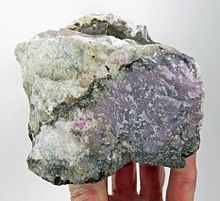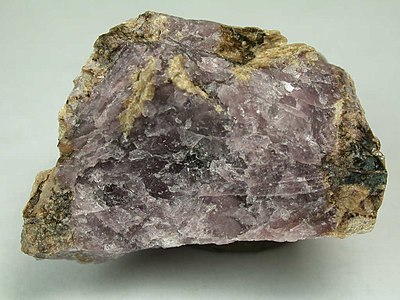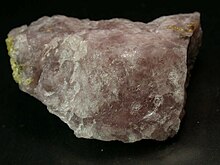Ussingite
| Ussingite | |
|---|---|
| Ussingite (purple) and Vuonnemit (yellowish) from the Umbozero Mine, Alluaiw , Kola Peninsula, Russia (size: 3.9 × 2.7 cm) | |
| General and classification | |
| chemical formula | Na 2 [OH | AlSi 3 O 8 ] |
|
Mineral class (and possibly department) |
Silicates and Germanates |
|
System no. to Strunz and to Dana |
9.EH.20 ( 8th edition : VIII / J.14) 76.03.03.01 |
| Crystallographic Data | |
| Crystal system | triclinic |
| Crystal class ; symbol | triclinic pinacoidal; 1 |
| Space group | P 1 (No. 2) |
| Lattice parameters |
a = 7.256 Å ; b = 7.686 Å; c = 8.683 Å, α = 90.75 °; β = 99.75 °; γ = 122.48 ° |
| Formula units | Z = 2 |
| Physical Properties | |
| Mohs hardness | 6 to 7 |
| Density (g / cm 3 ) | measured: 2.457 to 2.49; calculated: 2.51 |
| Cleavage | completely according to {110} and {1 1 0} |
| Break ; Tenacity | uneven; brittle |
| colour | white, pink, light violet to blue-violet, reddish-violet |
| Line color | White |
| transparency | transparent to translucent |
| shine | weak fat gloss to glass gloss; weak pearlescence on cleavage surfaces |
| Crystal optics | |
| Refractive indices |
n α = 1.504 n β = 1.509 n γ = 1.545 |
| Birefringence | δ = 0.041 |
| Optical character | biaxial positive |
| Axis angle | 2V = measured: 32 to 39 °; calculated: 42 ° |
| Other properties | |
| Chemical behavior | soluble in HCl |
Ussingite is a rarely occurring mineral from the mineral class of " silicates and germanates ". It crystallizes in the triclinic crystal system with the chemical composition Na 2 [OH | AlSi 3 O 8 ], that is a sodium - aluminum silicate with additional hydroxide . Structurally it belongs to the layered silicates .
Ussingite is transparent to translucent and rarely develops tabular or pseudocubic crystals . It is mostly found in the form of fine-grained to coarse mineral aggregates of white, pink, light violet to blue-violet or reddish-violet color with white streak color .
Etymology and history

Was first discovered in the ussingite Ilimaussaq - intrusion in Kangerdluarssuq -Fjord near Narsaq in the southwest of Greenland and described in 1915 by Ove Bøggild Balthasar (1872 to 1956). He named the mineral after Niels Viggo Ussing (1864-1911), a Swedish professor of mineralogy and member of the Royal Danish Academy of Sciences .
classification
In the meanwhile outdated, but still in use 8th edition of the mineral classification according to Strunz , the usingite belonged to the department of "tectosilicates (tectosilicates), with zeolites ", where it was the only member of the unnamed group VIII / J.14 .
The 9th edition of Strunz's mineral systematics , which has been in effect since 2001 and is used by the International Mineralogical Association (IMA), assigns usingite to the division of "phyllosilicates". This is further subdivided according to the structure of the layers, so that the mineral can be found according to its structure in the sub-section "Transition structures between layered silicate and other silicate units ", where it is the only member of the unnamed group 9.EH.20 .
The systematics of minerals according to Dana , which is mainly used in the English-speaking world , assigns usingite to the class of "silicates" and there in the department of "framework silicates: Al-Si lattice". Here he is to be found as the only member of the unnamed group 76.03.03 within the subdivision "Framework silicates: Al-Si grids with other Be / Al / Si grids".
Crystal structure
Ussingite crystallizes triclinically in the space group P 1 (space group no. 2) with the lattice parameters a = 7.256 Å ; b = 7.686 Å; c = 8.683 Å; α = 90.75 °; β = 99.75 ° and γ = 122.48 ° as well as two formula units per unit cell .
properties
Ussingite is soluble in HCl .
Education and Locations
As a rare mineral formation, Ussingite could only be detected at a few sites, with around 30 sites being known to date (as of 2013).
At its type locality , the Ilimaussaq intrusion in Greenland, usingite formed as a secondary mineral in the local pegmatites and sodalite - syenites together with aegirine , microcline and natrolite . In the geologically similar find area Lowosero-Tundra on the Russian Kola peninsula , albite was found as a further paragenesis . In addition, the mineral was found on Kola on the Kukiswumtschorr , on the Yukspor and in the Vuonnemiok river valley in the Chibinen .
At Mont Saint-Hilaire is ussingite found in sodalite xenoliths in intruded, alkaline gabbro -Syeniten with Eudialyt , Griceit , Lovozerit , Lueshit , Natrophosphat and Villiaumit .
See also
literature
- OB Bøggild: Ussingite, a new mineral from Kangerdluarsuk. In: Journal for Crystallography and Mineralogy. Volume 54, 1915, pp. 120–126 ( PDF 382.7 kB )
- Hans Jürgen Rösler : Textbook of Mineralogy . 4th, revised and expanded edition. German publishing house for basic industry (VEB), Leipzig 1987, ISBN 3-342-00288-3 , p. 610 .
Web links
- Mineral Atlas: Ussingite (Wiki)
- Database-of-Raman-spectroscopy - Ussingite
- American-Mineralogist-Crystal-Structure-Database - Ussingite
Individual evidence
- ↑ a b Stefan Weiß: The large Lapis mineral directory. All minerals from A - Z and their properties . 5th, completely reworked and supplemented edition. Weise, Munich 2008, ISBN 978-3-921656-70-9 .
- ↑ Webmineral - Ussingite
- ^ A b c G. Rossi, V. Tazzoli, L. Ungaretti: The crystal structure of ussingite. In: American Mineralogist. Volume 59, 1974, pp. 335-340 ( PDF 697.5 kB )
- ↑ a b c Ussingite. In: John W. Anthony, Richard A. Bideaux, Kenneth W. Bladh, Monte C. Nichols (Eds.): Handbook of Mineralogy, Mineralogical Society of America. 2001 ( PDF 73.1 kB )
- ↑ a b c d e Mindat - Ussingite
- ^ Friedrich Klockmann : Klockmanns textbook of mineralogy . Ed .: Paul Ramdohr , Hugo Strunz . 16th edition. Enke , Stuttgart 1978, ISBN 3-432-82986-8 , pp. 789 (first edition: 1891).
- ↑ Mindat - Number of localities for Ussingit
- ↑ Find location list for Ussingite at the Mineralienatlas and at Mindat

